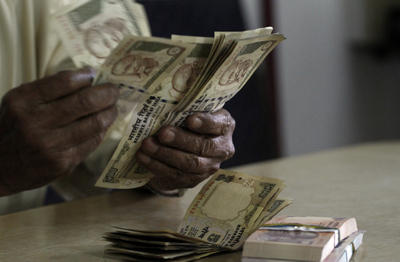There has been no spectacular or abrupt change in the Indian economy’s macro fundamentals over the last couple of months that could have possibly triggered the rupee’s fall, making it Asia’s worst performing currency. But there are multiple factors, both domestic and international, which are responsible for the current scenario. ‘Policy paralysis’; tight monetary policy; high inflation; and a gradual, overall weakening of macro fundamentals have slowed India’s growth. The rupee’s rapid fall reflects investors’ lack of confidence in the Indian economy, which is expected to grow at around 7 per cent this year, lower than the previous target of 8.5 per cent.
Slowing growth can also be attributed to the looming European debt crisis, as most of the European banks and financial institutions have significant exposure in developing countries. The outflow of capital (as investors pull out of India) and slow capital inflows over the last few months have both contributed to the problem.
Though the Reserve Bank of India (RBI) could intervene in the market to reduce volatility and mitigate panic, it is yet to take any action — and for the time being is leaving the markets to determine the rupee’s value. The finance minister’s view is that intervening in the foreign exchange market may not work given the global uncertainty caused by the European crisis and the withdrawal of funds from India by foreign institutional investors. But the central bank’s governor has hinted that market intervention may be used if necessary. Perhaps the RBI should have intervened last year when the rupee was appreciating, instead of leaving it entirely to the market.
Traditionally, depreciation is good for exports and bad for imports, a situation which generally improves a country’s trade balance — but under the current circumstances, this will not occur. Being a net importer, India’s currency depreciation increases the price of inputs, which in turn affects the manufacturing sector. The increased cost of inputs such as petroleum products, steel and rubber adds to the cost of production. In some industries such as automobiles, electronics and computer hardware, the increased costs will be passed onto consumers, contributing to further price increases. More importantly, the rising costs of production reduce profit margins and overall investment activity. The favourable impact on exports is modest, and confined to only a few sectors, as consumer demand is slowing in the US and Europe.
The present scenario does not bode well for India’s external sector and fiscal deficits. Given the price increases on imports, and the extremely limited benefits this will bring to exports, the trade deficit is likely to go up. In addition, the drop in capital inflows is likely to increase the current account deficit. The prospect of a higher current account deficit, and higher budget deficit due to increases in subsidies and slowing growth, will make investors in general — and foreign investors in particular — more sceptical about the Indian economy. There are already whispers in policy circles and among academics about the difficulty of achieving the fiscal deficit target of 4.6 per cent of GDP, and that the target for the current fiscal year is likely to be more than 5.5 per cent.
Overall, it looks like India’s growth story has been derailed, at least for the short term. The government is doing the right thing by speeding up pending reforms — such as FDI in retail and approving infrastructure projects — in order to signal confidence to foreign investors and thereby increase capital inflows. The government needs to fast-track reforms in banking, insurance and FDI to give the impression that India is still a safe haven for investors, with the second-highest growth rate in the world. This would ease pressure on the rupee, which would gradually stabilise.
Yet the government recently withdrew its recent politically sensitive decision to allow FDI in multi-brand retail after the announcement precipitated a great deal of animosity from right-wing opposition parties including the Bharatiya Janata Party (BJP), the left-wing Communist Party and other alliance partners of the Government. The Government succumbed to the pressure and announced that it would put FDI in retail on hold in the first week of December. Nobody is certain how long this suspensionwill last but it is clear that the matter has been postponed at least until the five state elections due in 2012 are over. The decision has created uncertainty in the minds of investors and the negative results are already being seen in Indian stock markets. This will put further pressure on the rupee. Though the benefits of FDI in retail are debatable, a complete rollback of this policy will send the wrong signal to investors regarding the government’s dedication to carrying out serious policy reforms. This backflip on FDI policy in regard to multi-brand retail FDI makes it unlikely that any further decision on FDI in insurance and the banking sector, among others, will be forthcoming.
The government should create incentives for non-resident Indians to remit money and invest in India, and for corporations to raise dollars through external commercial borrowings. Remittances have been somewhere around US$25–30 billion (around 3 per cent of GDP) per annum over the last few years — a significant amount, which helps with India’s balance-of-payments problems, and with its performance in the foreign exchange market.
Pravakar Sahoo is Associate Professor at the Institute of Economic Growth, Delhi. Views are personal.

